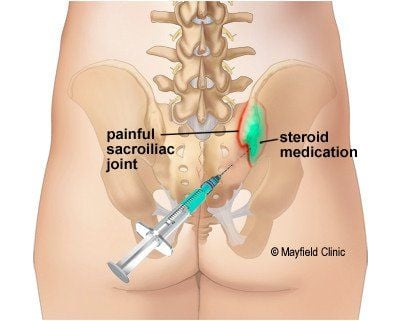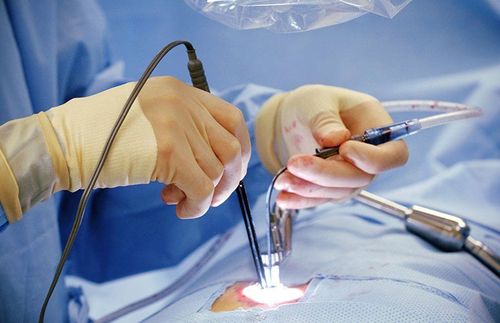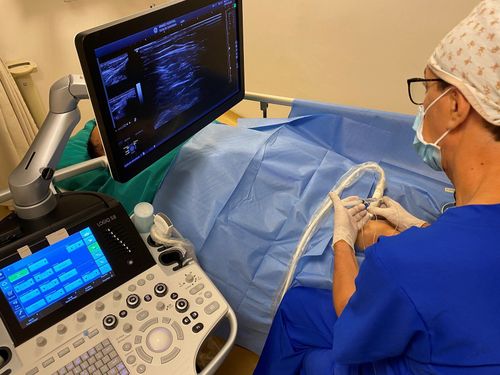This is an automatically translated article.
Article by Doctor, Specialist I Bui Hanh Tam - Anesthesiologist, resuscitation and pain treatment - Department of Anesthesiology and Anesthesia - Vinmec Times City International Hospital
Sacroiliac joint pain is pain in the lower back and buttocks. The pain is caused by injury, trauma to 1 joint or 2 joints between the spine and the right and left hip bones. Sacroiliac joint pain can mimic other conditions, such as a herniated disc or problems with the hip bones.
1. The position of the sacroiliac joint on the body
The sacroiliac joint is located between the pelvis and sacrum, connecting the spine to the hips. The two joints provide support and stability to the spine and pelvis and play an important role in absorbing impact when walking and lifting the body. Viewed from the back, this joint is located below the waist, where two indentations are visible, more prominent in women.
Watch now: Pain from sacroiliitis in women
2. Causes of sacroiliac joint pain
Strong ligaments and muscles support the sacroiliac joints. In order for the body to be flexible, the joints have a low amplitude of movement. As we age, bones and joints become drier, less flexible due to degeneration, reducing the amount of mucus that causes cartilage wear. As cartilage wears down, bones can rub against each other causing pain. The sacroiliac joint is a fluid-filled synovial joint. This type of joint has free nerve endings that can cause chronic pain if the joint degenerates or moves improperly.
Sacroiliac joint pain can range from mild to severe depending on the severity and cause of the injury. Accordingly, acute sacroiliac pain occurs suddenly and usually resolves within a few days to a few weeks, while chronic sacroiliac pain persists for more than three months. Pain all the time can get worse with certain movements.
Common causes are as follows:
Sacroiliac joint pain occurs when the movements of the pelvis are out of sync on both sides. Irregular movements can occur when one leg is longer or weaker than the other, or when there is arthritis in the hip and knee problems. When the ligaments around the joint are too loose or too tight due to falls, work injuries, car accidents, pregnancy and the birth of a baby. After hip and spine surgery (opening of the posterior vertebral arch or after spinal cementation). Autoimmune diseases such as ankylosing spondylitis. In addition, mechanically altered conditions such as wearing walking shoes after foot or ankle surgery, or wearing inappropriate footwear, can lead to sacral degeneration leading to associated arthritis.

Đau khớp cùng chậu có biểu hiện đau bắt đầu ở lưng dưới và mông
3. Symptoms of sacroiliac joint pain
Usually, patients with sacroiliac joint pain have symptoms such as:
Pain begins in the lower back and buttocks Pain spreads to the lower hip, groin or upper thigh. Usually the pain is on one side, but it can happen on both sides, accompanied by numbness or tingling in the leg and a feeling of leg weakness. The patient has more pain when sitting, standing, sleeping, walking or climbing stairs. Some people have trouble sitting for long periods of time, sitting in a car, standing or walking for too long. The pain may be worse with a sudden change in position from sitting to standing, standing on one leg on the affected side, or climbing stairs.
4. How to diagnose pelvic joint pain?
At Vinmec International General Hospital, pain specialists will ask patients, directly examine the patient with palpation and manipulation movements to guide the diagnosis.
Necessary diagnostic tests such as X-rays, CT scans, or MRIs may be ordered and help check for other problems related to the spine and hip joints. Blocking the nerves that supply the sacroiliac joint, both relieves pain and helps doctors make an accurate diagnosis

Tiêm thuốc giảm đau điều trị đau khớp cùng chậu
5. How to treat pelvic joint pain?
Whether or not sacroiliitis can be cured is a matter of concern for many people when pelvic pain occurs. In fact, the sacroiliac joint is a semi-motor joint, so minimally invasive intervention is preferred.
Non-surgical methods: Using physical therapy, chiropractic, oral drugs, topical drugs, fixing joints with tape. Inject pain reliever, anti-inflammatory into the sacroiliac joint. This injection can be repeated every 6 months if pain recurs. The procedure is done at the Pain Clinic of Vinmec Times City International Hospital and the patient can go home 1 hour after the procedure. Pressure or burn the nerves that supply the sacroiliac joint, interrupting nerve transmission from the pain area through the spinal cord, to the brain to help relieve pain. Surgical method: Bone graft or artificial device to stabilize the joint.
6. How to prevent pelvic joint pain?
Pain reduces quality of life. Therefore, after the treatment process, the patient must have a strategy to minimize the recurrence of pain. So patients should note:
Proper technique of lifting heavy objects Good posture when sitting, standing, moving and sleeping Exercise regularly with stretching Maintain good nutrition, healthy weight, mass lean body Stress reduction and relaxation: meditation or yoga properly Don't smoke Sacroiliac joint pain makes patients feel uncomfortable, detrimental and reduces quality of life. Symptoms of pelvic joint pain are very obvious. Therefore, when seeing these signs, patients should go to medical centers for examination and treatment.
If you and your loved ones have pelvic pain, please contact the Pain Clinic - Vinmec International General Hospital for advice, examination and diagnosis, and plan treatment with leprosy measures. nerve block if necessary. All procedures are performed by experts in pain management and under the guidance of the most modern neuro-ultrasound machines available today.
Please dial HOTLINE for more information or register for an appointment HERE. Download MyVinmec app to make appointments faster and to manage your bookings easily.













